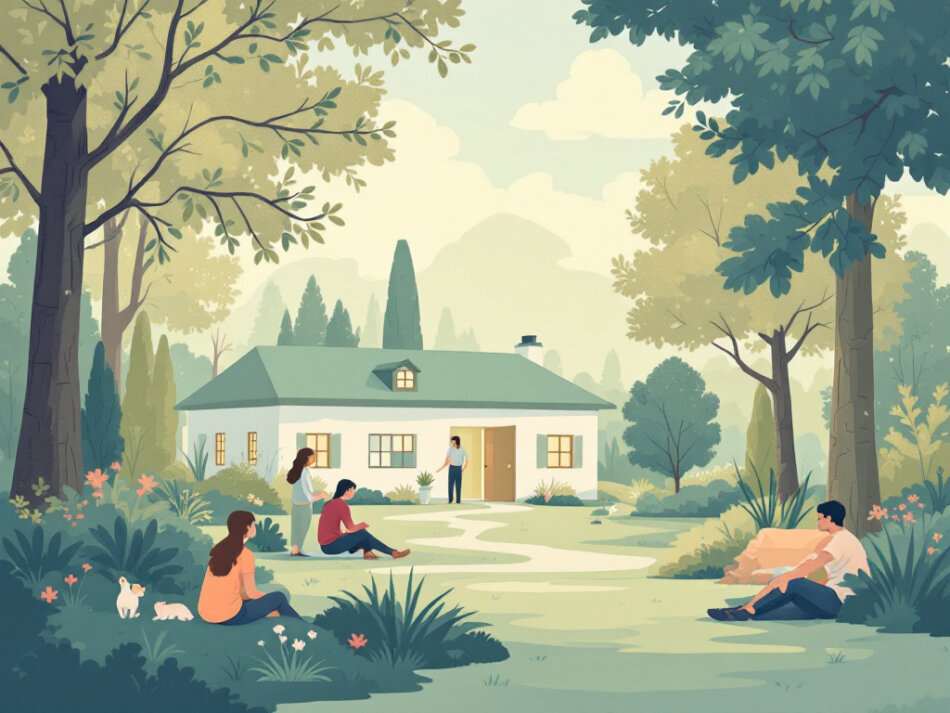Understand residential therapy
Residential therapy for traumatized teens provides a full-time, structured environment where your child can focus on healing away from everyday stressors. In these programs, teens live on-site in a supervised setting, receiving around-the-clock clinical care and support. Whether your teen has experienced abuse, loss, or other traumatic events, residential treatment offers a safe space to work through symptoms under professional guidance.
Many programs use a multidisciplinary approach, combining psychiatrists, psychologists, social workers, and certified therapists to address both psychological and physiological effects of trauma [1]. This team monitors mental health symptoms, manages medications, and adjusts treatment plans as your teen progresses. By removing triggers found at home or school, residential care helps stabilize emotional crises and lay a foundation for long-term recovery.
Recognize trauma symptoms
Before selecting a program, it’s important to identify how trauma affects your teen. Trauma symptoms can be subtle or severe and may include:
- Intrusive memories such as flashbacks or nightmares
- Heightened arousal including irritability, hypervigilance, and trouble sleeping
- Emotional regulation difficulties like sudden anger outbursts or numbing
- Avoidance behaviors such as withdrawing from friends, family, or activities
- Physical complaints including headaches, stomachaches, or fatigue
If your teen struggles with panic attacks, self-harm urges, or overwhelming fear, a therapy for teens with flashbacks and fear may be part of an effective plan. Early intervention can prevent chronic Post-Traumatic Stress Disorder and reduce long-term mental health challenges.
Explore treatment modalities
Residential centers employ evidence-based therapies to help teens process trauma, build coping skills, and regain emotional balance. Key modalities include:
Trauma-focused cognitive behavioral therapy
Trauma-Focused Cognitive Behavioral Therapy (TF-CBT) combines cognitive restructuring and exposure techniques to help teens reframe negative thoughts and reduce trauma reminders. TF-CBT teaches:
- Identifying and challenging distorted beliefs
- Developing healthy coping strategies for triggers
- Practicing relaxation and grounding exercises
TF-CBT is often paired with family involvement to reinforce skills at home, making it a cornerstone of trauma-focused treatment for teens.
Eye movement desensitization and reprocessing
Eye Movement Desensitization and Reprocessing (EMDR) helps your teen reprocess traumatic memories through guided eye movements or bilateral stimulation. EMDR can:
- Reduce the emotional intensity of trauma memories
- Improve self-esteem and sense of safety
- Accelerate healing compared to talk therapy alone
For specialized care, consider a teen emdr therapy program that integrates EMDR with other trauma services.
Dialectical behavior therapy
Originally designed for borderline personality disorder, Dialectical Behavior Therapy (DBT) is highly effective for trauma survivors who struggle with emotional dysregulation and self-harm. DBT teaches skills in:
- Mindfulness, to stay present and reduce rumination
- Distress tolerance, to cope with crises without harmful behaviors
- Emotion regulation, to manage intense feelings
- Interpersonal effectiveness, to communicate needs assertively
A trauma and self-harm recovery program often uses DBT to reduce impulsivity and promote healthier coping.
Holistic and experiential therapies
Beyond talk-based approaches, residential programs may offer:
- Art therapy, dance/movement therapy, or music therapy
- Equine-assisted therapy and wilderness programs
- Yoga, meditation, and mindfulness practices
- Nutritional counseling and physical exercise routines
These experiential therapies nurture self-expression, enhance self-esteem, and support overall wellness. Programs like Newport Academy include family-centered interventions and creative therapies to foster connection and healing [2].
Compare program types
Residential care varies in intensity, duration, and setting. Understanding your options helps you choose the right fit.
Partial hospitalization vs intensive outpatient
If your teen needs daily therapeutic support but can return home each night, consider:
- Partial hospitalization programs (PHP)
- 4 to 6 hours of treatment per day, 5 days a week
- Structured schedule of individual, group, and family therapy
- On-site school or academic support
- Intensive outpatient programs (IOP)
- 3 to 4 hours per day, 3 to 5 days a week
- Flexibility to maintain some home responsibilities
- Suitable for teens who have stabilized after residential care
SunCloud Health offers both PHP and IOP for adolescent trauma, allowing teens to continue school and collaborate with educators [3].
Residential center examples
When you evaluate full residential options, note differences in focus, duration, and population served. Here are a few models:
| Program | Location | Age/Population | Therapies | Length |
|---|---|---|---|---|
| SunCloud Health | Naperville, IL | Adolescents 13–17 | CBT, DBT, art therapy, family therapy | 30–90 days |
| Newport Academy | Multiple states | Teens 12–18 | CBT, DBT, EMDR, ABFT | 30–60+ days |
| Family First Residential Treatment | FL (Palm Beach) | Boys 12–18 | Individual, group, family therapy | 45–90 days |
| Reno Behavioral Healthcare Hospital | Reno, NV | Girls 13–17 | Psychosocial interventions, rec therapy | ~30 days |
- SunCloud Health’s dedicated girls’ center, led by Dr. Ivy Burgo, emphasizes trauma stabilization and hope restoration.
- Newport Academy reports significant improvements in anxiety, depression, and attachment, with gains sustained nine months post-discharge.
- Family First’s compassionate residential program integrates daily routines to teach time management and coping skills [4].
- Reno Behavioral’s psychiatric residential program offers 24-hour oversight and multiple therapy modalities [5].
Assess insurance options
Residential therapy can be costly, but many centers accept commercial and Medicaid insurance. To verify coverage:
Finding programs that accept insurance
- Search specifically for a trauma recovery program that accepts insurance or trauma therapy that accepts insurance.
- Consult your insurance provider’s mental health network directory.
- Ask prospective centers about in-network status, preauthorization requirements, and coverage limits.
Verifying coverage and benefits
- Confirm your policy’s inpatient mental health benefits and deductible amounts.
- Request an itemized estimate, including room charges, therapy sessions, and ancillary services.
- Check if your plan covers step-down care such as PHP or IOP after residential discharge.
Early proactive communication with insurers prevents unexpected out-of-pocket expenses and helps you plan a financially sustainable treatment path.
Build family involvement
Your support is key to your teen’s healing. Residential programs integrate families to reinforce progress and improve communication.
Role of family therapy
Family therapy sessions help you and your teen:
- Identify and modify unhealthy interaction patterns
- Learn strategies to respond to emotional crises
- Rebuild trust and attachment bonds
Programs like Newport Academy use Attachment-Based Family Therapy (ABFT) to restore parent-child connections essential for long-term recovery.
Improving communication at home
- Practice active listening, validating your teen’s emotions without judgment
- Establish consistent routines that mirror therapeutic structures
- Use coping tools learned in treatment, such as grounding exercises or emotion regulation techniques [6]
Ongoing family engagement fosters a stable environment where your teen can continue to grow and apply skills learned in residential care.
Plan aftercare and reintegration
Successful transition from residential therapy requires careful planning and support.
Step down programs
Before discharge, work with the treatment team to outline a continuum of care:
- Partial hospitalization (PHP) or intensive outpatient (IOP) settings
- School reintegration plans with academic accommodations
- Individual or group therapy referrals in your community
Well-designed aftercare plans reduce relapse risk and maintain therapeutic momentum.
School and community support
- Coordinate with school counselors to implement an individualized education plan (IEP) or 504 plan if needed
- Enroll your teen in peer support groups or extracurricular activities that promote social connectedness
- Maintain regular check-ins with outpatient therapists or case managers
By creating a supportive network that spans home, school, and community, you reinforce your teen’s resilience and long-term recovery.
Conclusion
Residential therapy for traumatized teens offers a comprehensive, evidence-based approach to address trauma symptoms and build lifelong coping skills. By understanding program types, treatment modalities, insurance considerations, family involvement, and aftercare planning, you can make informed decisions that support your teen’s journey to healing. When you choose the right residential program, you give your child the opportunity to process past wounds, regain emotional stability, and embrace a brighter future.











